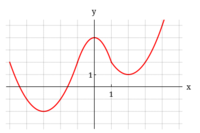Hi MathStudent. On a graph, local minimums and maximums appear as turning points. Looking at your graph, we see two local areas where the graph is decreasing and then turns around and is increasing. The lowest point in each of those areas represents a "local" minimum value of y.
There's also a turning point where the graph is increasing and then turns around and is decreasing. The highest point in that "local" area is a local maximum y-value.
Some people would define the y-value at the graph's two endpoints as local maximums, also (because each endpoint shows the largest y-value in its respective "local" area), but I would ignore the endpoints in this exercise because the question asks for only one local maximum.
It's customary to report local minimums and maximums as an (x,y) pair because that shows both the minimum/maximum (the y-value) and the
location where it occurs (the x-value).
As Jomo posted, the first local minimum of y (reading the graph left-to-right) is -2, and it occurs when x is -3. We can report that local minimum as the point (-3,-2).
Let us know, if you need more help. Please include what you've done so far.
?


